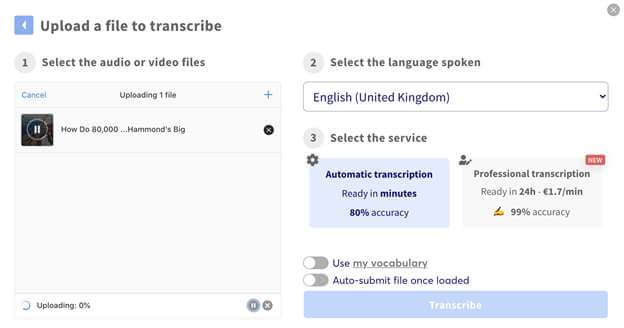Remote workplaces are constantly looking for new ways to boost productivity. More than 60% of people are now working remotely, and companies are incorporating different technological innovations to ease workflow. One widely leveraged technology that can help improve communication and productivity is audio-to-text technology.
A few key factors have played an important role in the widespread adoption of voice-to-text technology. First, audio-enabled devices are better than ever. We can now do several tasks with our voice alone, like recording briefs, creating transcripts, and summarizing important points from a meeting.

The second crucial factor is the improvement in NLP (natural language processing) technologies. AI-driven devices can now recognize our voices accurately and generate meaningful replies. For example, many of us now use virtual voice assistants to do regular household tasks. The challenge now is to extend the same use cases to workplaces.
Contents
- The impact of using audio-to-text technology on workplace productivity
The impact of using audio-to-text technology on workplace productivity
The most apparent use of audio-to-text technology is to dictate instructions to computer software. Instead of our keyboards and mice, we can now also use our voices to enter information. Let’s find out more about how these innovations can improve workplace productivity.
Rudimentary speech dictation software and its limitations

The early speech recognition tools were clunky and difficult to use. For example, you would have to speak one word at a time with pauses before and after. It used to take a substantial amount of time to train users to use these tools. As a result, their use in workplaces never picked up steam.
That scenario has started to change since the early 2000s. Text-to-speech came earlier, followed by the more recent speech-to-text. However, text-to-speech doesn’t possess the capabilities of audio-to-text, primarily because it serves fewer use cases.
Fortunately, now we are at a stage where audio-to-text tools are affordable and widely used. Anyone can now use a fully capable voice-to-text tool directly on their personal computers and smartphones. There are plenty of free tools that anyone can use to realize the potential of this technology.
Advanced speech recognition software and its promises
Modern speech recognition tools are not only advanced in their capabilities but also very easy to use. For example, you can now automate a set of processes that will be initiated the moment you give a speech command. You can send emails, write documents, send voice notes, and a lot more. Virtual voice assistants, when paired with the right IoT devices, can even detect your motions and gestures to initiate a routine.
Workplace productivity isn’t possible with rudimentary audio-to-text technologies. What we need are state-of-the-art voice recognition systems that can boost every aspect of productivity.
How does audio-to-text technology improve workplace productivity?
Audio-to-text technology is the next revolution in communication systems. For the most part, we still don’t use voice commands to execute tasks. But the use of audio-to-text technology in workplaces can bridge this gap.
Here are some ways in which audio-to-text technology will improve productivity in workplaces.
Take notes and write briefs by converting MP3 to text

If your professional responsibilities include taking notes and writing briefs, audio-to-text technology will come in handy for you. For example, you can record the audio of a meeting as an MP3 file. Then you can convert MP3 to text using a tool like HappyScribe. This process will save you hours and make briefs more detailed.
The same method is useful for e-learning as well. You can record an entire lecture and later transcribe it to text. Then you can annotate and edit the text to create effective notes. This use case is not restricted to workplaces. Students and learners from different sectors can take better notes with audio-to-text technology.
Everyone from an intern to a C-suite executive can perform more efficiently with audio-to-text technology. Any task that requires us to listen to instructions or information and create briefs/notes from them will be smoother with audio-to-text technology.
However, audio-to-text transcription alone is not enough to handle these tasks efficiently. You also need text editors, presentation tools, design tools, etc. to create effective briefs and notes. The use of audio-to-text technology makes the process faster, easier, and more intuitive.
Empower remote offices with transcription tools
Remote offices face specific challenges in terms of coordination and communication. One of the reasons behind this is the inefficiency of text-based communication. Virtual meetings also lack several communicative elements that can be improved with audio-to-text technology.
Sending voice memos is an effective communication tool that doesn’t eat up time, but also conveys clear information. When combined with transcription tools, voice memos become even more effective as a medium of conversation. For instance, you can collate voice memos from different sources and compile them into a unified document using audio-to-text technology. This is one of the key reasons behind the increasing use of audio-to-text technology in remote offices.
Audio transcription technology also helps increase mobility among remote teams. If you forget to carry your laptop, you won’t have to pause work until you go back to your home. Audio-to-text technology can help you communicate and work from anywhere. All you’d need is a smartphone and a reasonably quiet environment.
Record and transcribe virtual conferences to make them accessible
Virtual conferences have become a part of our everyday lives. At the same time, the difficulty of attending conferences from our homes is undeniable. If you don’t want to miss out on anything important, you can use audio-to-text technology to record and transcribe vital sections of the conference.
Audio-to-text also makes online conferences, meetings, and e-learning resources more accessible. Poor internet connectivity holds back many people from making the most of video-based online resources. Audio-to-text technology is the best answer we have right now to combat these issues.
Sector-wise impact of audio-to-text technology
One of the biggest impacts of audio-to-text technology is that it can be employed across sectors. From healthcare to education, workflow in every sector can become more efficient with the use of audio-to-text technology. Let’s learn about a few sectors where this technology shows the most promise.
Education
The education sector will undoubtedly benefit from audio-to-text technology for the reasons we already discussed. First, education will become more accessible. Second, the quality of educational resources will improve as learners get a better grasp of learning materials. Lastly, educators will also benefit from the time and cost-saving aspects of audio-to-text technology.
Content creation

Content creation is another area where audio-to-text technology will prove to be revolutionary. Many creators already use audio-to-text technology to some degree to create content. For example, podcasters can create bite-sized or long-form content from their podcasts using audio transcription technology.
Similarly, B2B and B2C content creators can put out more content in less time through audio transcription. It’s one of the easiest ways to repurpose different content forms and keep the content volume up. If you are a content creator, you should start using this technology to notice immediate benefits.
Healthcare
One-on-one consultations with doctors are one of the best use cases for audio transcription technology. Suppose you visit a doctor for a checkup and the doctor has to prescribe lifestyle changes and medications. Instead of writing and typing out everything, the doctor can use audio transcription software to automatically generate prescriptions. It will save time and reduce errors at the same time.
Mental health care and therapy will also become more effective with the use of audio-to-text technology. Therapists would be able to work faster and at the same time, spend more time with their clients instead of writing notes.
The same benefits apply to those taking therapy. They can engage in the conversation more deeply while taking automated notes of everything the therapist says.
It’s only a matter of time before almost all sectors incorporate audio transcription technology to some extent, just as we have done with text-based messaging apps.
Challenges of audio-to-text technology
While audio-to-text technology is very promising, it isn’t without limitations. Some core limitations of the technology prevent its widespread adoption and use.
First, the problem of accents and dialects needs to be solved for audio-to-speech technology to be widely used. People have a range of accents in diverse workplaces, and speech recognition tools must have the ability to understand different accents, dialects, and even colloquial use of language.
The second problem of speech recognition technology is inaccuracy. These tools often pick up the wrong words, especially when it comes to individual names and homophonous words.
The third challenge is that of language. The AI language models upon which audio-to-text tools are based primarily operate in and with English. But only 17% of the global population speaks English. Audio-to-speech technology has to incorporate more languages to become a household technology.
These are the three key challenges of audio-to-text technology at the moment.
Conclusion
Audio-to-text technology is bridging an important communication gap between humans and machines.
As technology becomes more immersive and interactive, voice-to-text technology will be even more useful. At present, we are only scratching the surface of what’s possible with voice-to-text interfaces.
We hope this article helps you understand the potential of this technology in workplace productivity.



